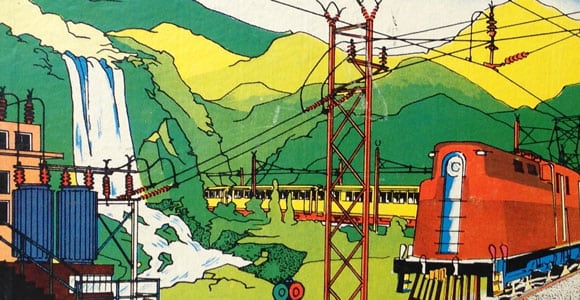Always looking to expand my mind, I recently purchased an educational text on electricity. It is written on a level that takes this technically complex product and puts it on a down-to-earth level. The authors, both university professors, do a great job of explaining this innovative product and the ways it impacts people’s everyday lives.

The book, “Electricity Comes to Us,” was published in 1937. Reading it today is a lot like opening a time capsule and trying to imagine what life was like in that era.
For the period in which it was written, the book does a great job explaining electricity, which at that time was far from universally available. The text walks through how electricity is generated, transmitted to homes and used by individuals. It even describes how to electrify a doll house. (We don’t recommend that!)
The section of the book that explains how electricity travels from the generating station (hydroelectric or coal) to homes is titled “The City Power Lines.” Not only was electricity carried into the city at 550 volts, it wasn’t carried into rural areas at any voltage.
Today, even the most remote part of Tennessee is likely to have nearby distribution lines that carry electricity at 7,200 volts or greater.
The advances in the distribution of electricity made me ponder the book as a time capsule. What went through the minds of the authors when they described how electricity was used? There is a drawing of an electric toaster in the book that was innovative and futuristic then but would be terribly unsafe in any home today.
Here’s how my friend Paul Wesslund frames that thought in a recent Kentucky Living magazine column:
“How didn’t you use electricity 40 years ago? You didn’t use it to charge a mobile phone or an iPhone. You might have used it when you switched on your record turntable to play music from a 12-inch, black, vinyl disk.
You most likely didn’t use it to power a computer. And even if you did have one of those garage-sized machines, there was no Internet to connect it to hundreds of millions of people, libraries and businesses all over the world.
Today, electric cars, solar and wind energy and efficiency practices are turning from novelties into more commonplace power practices. In 1973 these energy options were so expensive they seemed like science fiction.
The list goes on: TV remote controls, microwave ovens, flat-screen TVs, GPS, hospital MRIs.
“Which of those things could you have confidently predicted in 1973? What are your predictions for 2053?”
The authors of “Electricity Comes to Us” could not have possibly fathomed the many ways we generate and use electricity today. I don’t know that anyone could have done so. Given the advances that have transpired since 1937, I don’t know that our predictions for 2053 would be any better.
It’s difficult enough to maintain today’s electric grid. And the rapidity with which technology advances, it’s difficult and expensive to plan for the future. However, the goal today is the same as it was in 1937: to bring electricity to the homes of the user. No matter how you’ll use electricity in 2053, we’ll be here to bring it to you.



